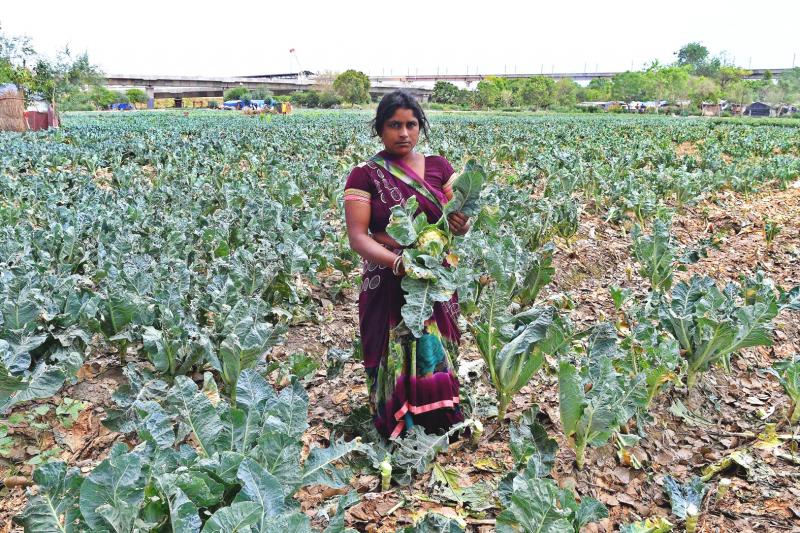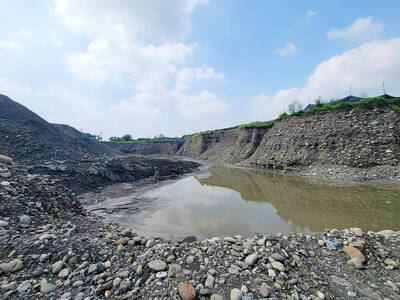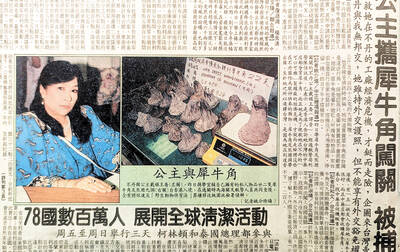Many of the landmarks of Paras Tyagi’s life remain the same in Budhela village in Delhi where he grew up: the house he lived in, the school that he, his father and grandfather attended, the homes of neighbors he knew as a child.
But the farmland that Tyagi’s grandfather once owned is long gone, a pond that the cattle used to drink from has been filled in and walled off, and around the village, high-rise apartment and office blocks and a Metro station have sprung up.
Budhela is one of 135 urban villages in Delhi, settlements that are exempted from building codes and excluded from its plans — leaving nearly a million people, most of whom have no titles to their homes, without a blueprint for the future.

Photo: AFP
“We are among Delhi’s oldest residents, yet we are losing what we had, and suffering from pollution, congestion and gentrification,” said Tyagi, co-founder of the Center for Youth Culture Law and Environment (CYCLE), a public policy non-profit.
“Urban villages provide housing options for low-income families and migrant workers, commercial spaces for factory outlets and upscale markets, but they are largely neglected and desperately in need of infrastructure upgrades,” he said.
Large parts of Delhi were once agricultural. As these were acquired by authorities, some residents stayed on in adjacent areas that came to be known as lal dora, or red thread in the Hindi language, for the red line that demarcated them.
Some lal dora lands were designated as urban villages — small islands in the constantly changing metropolis — growing in number from 20 in 1962, when Delhi’s first master plan was made, to 135 today. The city also has scores of rural villages.
Lacking property records, the governance structure of their rural counterparts and left off the city’s plans, Delhi’s urban villages are largely run by influential families, with little oversight by civic authorities, residents and urban experts say.
As pressure increases to integrate lal dora lands into the city’s master plan, authorities must consider their unique character and history, said Kanchi Kohli, a fellow at the Center for Policy Research, a think tank in Delhi.
“Lal dora areas have grown exponentially with risky and inadequate civic infrastructure. These areas need to be a part of Delhi’s urban planning, but their inclusion has been and continues to be a complex process,” she said.
“Any attempt to integrate them into the master plan will need to protect them from land grabs, and be a careful, informed process that looks at class stratification and historical marginalization,” she said.
HISTORICAL VALUE
Almost 70 percent of the world’s population will live in urban areas by 2050, according to estimates by the UN.
In India, as elsewhere, rapid urbanization is putting pressure on governments to build more apartment blocks and metro rail networks, which has led to the razing of old buildings and neighborhoods.
Cities risk losing not just their history and heritage, but also the traditional knowledge that is key to promoting inclusiveness, sustainability and resilience, according to urban experts.
This is particularly true of large cities such as Delhi and Mumbai, which every day draw thousands of migrants from India’s villages looking for better economic opportunities.
Faced with a critical shortage of affordable housing in the cities, many settle in slums and other informal settlements, which lack basic amenities such as drinking water and toilets.
In Delhi, urban villages with lower rents compared to flats, and with better amenities than slums, have become the preferred option for students, migrant workers and small businesses that often rent the ground floor of the low-rise buildings.
Some, like Hauz Khas and Shahpur Jat, which abut upscale neighborhoods, have lured designer boutiques and trendy cafes and bars — a reflection of how land use in urban villages has been altered over the years, sometimes illegally, said Kohli.
A scheme to improve civic services in urban villages was launched by the Delhi Development Authority (DDA) in 1979, and then transferred to the Municipal Corporation.
A committee set up by the federal housing ministry to study integrating lal dora areas into the Delhi Master Plan to 2021, noted in its 2007 report that urban villages had not seen the “desired and expected improvements of urbanization.”
It recommended “modern, decent living accommodation” for residents, proper amenities, a liberal land-use policy and updated property records.
Delhi’s Master Plan to next year noted that redevelopment of urban villages was a critical focus area, but failed to provide a separate legal framework, said Ruchita Gupta, an assistant professor at the School for Planning and Architecture in Delhi.
“If we bring urban villages under the same planning model, we will get the same high-density buildings,” she said.
“These settlements have their own indigenous character, and a cultural and historical value. Can we work with the existing fabric, and make customized norms with the involvement of the community?”
Leenu Sehgal, a planning commissioner at the DDA, said it was drafting new laws for the management of urban villages.
“We are re-examining all aspects, from sanitation to building codes, and we will have a framework in the next Master Plan to 2041,” she said, without giving further details.
DIGNITY AND RESPECT
Across India, cities have been slow to meet the needs of people living in informal settlements, with only a few introducing laws to upgrade housing and provide amenities — a task made more urgent by the spread of the coronavirus in slums.
Last year, the federal government said it would legalize nearly 2,000 unauthorized colonies in Delhi, upgrading infrastructure and giving more than 4 million poor residents the right to own their homes.
In Budhela, a settlement of 350 households and about 4,500 people, there is growing discontent with the narrow lanes that get waterlogged in the rains, the open drains and lack of green spaces.
Residents are also frustrated by their inability to use their homes as collateral for bank loans, as most do not have titles. The process of registering for one is too onerous and costly, Tyagi said.
“We are asking for just the basics, so we can live with dignity and respect,” he said, pointing to piles of trash lying by the road.
“But the lal dora is no man’s land — no one in the city wants to take responsibility. We don’t know what the future is.”

Last week the story of the giant illegal crater dug in Kaohsiung’s Meinong District (美濃) emerged into the public consciousness. The site was used for sand and gravel extraction, and then filled with construction waste. Locals referred to it sardonically as the “Meinong Grand Canyon,” according to media reports, because it was 2 hectares in length and 10 meters deep. The land involved included both state-owned and local farm land. Local media said that the site had generated NT$300 million in profits, against fines of a few million and the loss of some excavators. OFFICIAL CORRUPTION? The site had been seized

Next week, candidates will officially register to run for chair of the Chinese Nationalist Party (KMT). By the end of Friday, we will know who has registered for the Oct. 18 election. The number of declared candidates has been fluctuating daily. Some candidates registering may be disqualified, so the final list may be in flux for weeks. The list of likely candidates ranges from deep blue to deeper blue to deepest blue, bordering on red (pro-Chinese Communist Party, CCP). Unless current Chairman Eric Chu (朱立倫) can be convinced to run for re-election, the party looks likely to shift towards more hardline

Sept. 15 to Sept. 21 A Bhutanese princess caught at Taoyuan Airport with 22 rhino horns — worth about NT$31 million today — might have been just another curious front-page story. But the Sept. 17, 1993 incident came at a sensitive moment. Taiwan, dubbed “Die-wan” by the British conservationist group Environmental Investigation Agency (EIA), was under international fire for being a major hub for rhino horn. Just 10 days earlier, US secretary of the interior Bruce Babbitt had recommended sanctions against Taiwan for its “failure to end its participation in rhinoceros horn trade.” Even though Taiwan had restricted imports since 1985 and enacted

Enter the Dragon 13 will bring Taiwan’s first taste of Dirty Boxing Sunday at Taipei Gymnasium, one highlight of a mixed-rules card blending new formats with traditional MMA. The undercard starts at 10:30am, with the main card beginning at 4pm. Tickets are NT$1,200. Dirty Boxing is a US-born ruleset popularized by fighters Mike Perry and Jon Jones as an alternative to boxing. The format has gained traction overseas, with its inaugural championship streamed free to millions on YouTube, Facebook and Instagram. Taiwan’s version allows punches and elbows with clinch striking, but bans kicks, knees and takedowns. The rules are stricter than the